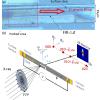当前位置:
X-MOL 学术
›
Phys. Rev. B
›
论文详情
Our official English website, www.x-mol.net, welcomes your feedback! (Note: you will need to create a separate account there.)
Evidence of charge density wave transverse pinning by x-ray microdiffraction
Physical Review B ( IF 3.7 ) Pub Date : 2020-03-24 , DOI: 10.1103/physrevb.101.125122 E. Bellec , I. Gonzalez-Vallejo , V. L. R. Jacques , A. A. Sinchenko , A. P. Orlov , P. Monceau , S. J. Leake , D. Le Bolloc'h
Physical Review B ( IF 3.7 ) Pub Date : 2020-03-24 , DOI: 10.1103/physrevb.101.125122 E. Bellec , I. Gonzalez-Vallejo , V. L. R. Jacques , A. A. Sinchenko , A. P. Orlov , P. Monceau , S. J. Leake , D. Le Bolloc'h

|
Incommensurate charge density waves (CDW) have the extraordinary ability to display non-Ohmic behavior when submitted to an external field. The mechanism leading to this nontrivial dynamics is still not well understood, although recent experimental studies tend to prove that it is due to solitonic transport. Solitons could come from the relaxation of the strained CDW within an elastic-to-plastic transition. However, the nucleation process and the transport of these charged topological objects have never been observed at the local scale until now. In this paper, we use in situ scanning x-ray microdiffraction with micrometer resolution of a sample designed to have sliding and nonsliding areas. Direct imaging of the charge density wave deformation is obtained using an analytical approach based on the phase gradient to disentangle the transverse from the longitudinal components over a large surface . We show that the CDW dissociates itself from the host lattice in the sliding regime and displays a large transverse deformation, ten times larger than the longitudinal one and strongly dependent on the amplitude and the direction of the applied currents. This deformation continuously extends across the macroscopic sample dimensions, over a distance 10 000 times greater than the CDW wavelength despite the presence of strong defects while remaining strongly pinned by the lateral surfaces. This two-dimensional quantitative study highlights the prominent role of the shear effect, which should be significant in the nucleation of solitons.
中文翻译:

X射线微衍射电荷密度波横向钉扎的证据
不适当的电荷密度波(CDW)具有非凡的能力,当将其提交到外部电场时会表现出非欧姆行为。尽管最近的实验研究倾向于证明这是由于孤子传输引起的,但导致这种不平凡的动力学的机理仍未得到很好的理解。孤子可能是由于拉伸的CDW在弹塑性转变中的松弛所致。但是,到目前为止,在局部规模上还没有观察到成核过程和这些带电拓扑对象的传输。在本文中,我们使用原位扫描X射线微衍射,其分辨率为被设计为具有滑动和非滑动区域的样本。电荷密度波变形的直接成像是使用基于相梯度的分析方法获得的,以在较大的表面上使横向分量与纵向分量分离。我们表明,CDW在滑动状态下从主体晶格中解离出来,并显示出较大的横向变形,比纵向变形大十倍,并且在很大程度上取决于所施加电流的幅度和方向。尽管存在严重的缺陷,但仍被侧面牢固固定,这种变形连续地在宏观样品尺寸上延伸,其距离比CDW波长大10 000倍。这项二维定量研究突显了剪切效应的突出作用,这在孤子成核中应发挥重要作用。
更新日期:2020-03-24
中文翻译:

X射线微衍射电荷密度波横向钉扎的证据
不适当的电荷密度波(CDW)具有非凡的能力,当将其提交到外部电场时会表现出非欧姆行为。尽管最近的实验研究倾向于证明这是由于孤子传输引起的,但导致这种不平凡的动力学的机理仍未得到很好的理解。孤子可能是由于拉伸的CDW在弹塑性转变中的松弛所致。但是,到目前为止,在局部规模上还没有观察到成核过程和这些带电拓扑对象的传输。在本文中,我们使用原位扫描X射线微衍射,其分辨率为被设计为具有滑动和非滑动区域的样本。电荷密度波变形的直接成像是使用基于相梯度的分析方法获得的,以在较大的表面上使横向分量与纵向分量分离。我们表明,CDW在滑动状态下从主体晶格中解离出来,并显示出较大的横向变形,比纵向变形大十倍,并且在很大程度上取决于所施加电流的幅度和方向。尽管存在严重的缺陷,但仍被侧面牢固固定,这种变形连续地在宏观样品尺寸上延伸,其距离比CDW波长大10 000倍。这项二维定量研究突显了剪切效应的突出作用,这在孤子成核中应发挥重要作用。


























 京公网安备 11010802027423号
京公网安备 11010802027423号